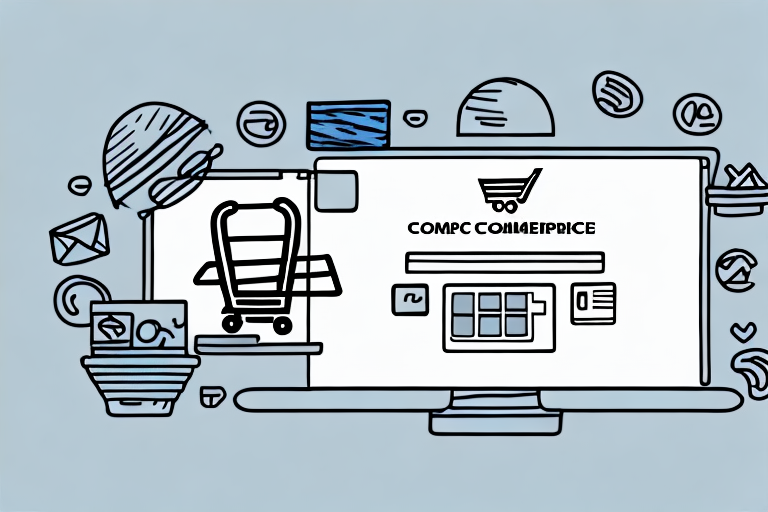.svg)
Content Marketing for E-commerce: Driving Sales through Compelling Copy
.svg)

In today's fast-paced digital world, content marketing has emerged as a powerful tool for driving sales in the e-commerce industry. With the rise of online shopping, businesses need to find innovative ways to captivate their audience and stand out from the competition. In this article, we will explore the importance of content marketing in e-commerce and discuss various strategies to create compelling copy that converts visitors into customers.
1. The Importance of Content Marketing in E-commerce
Effective content marketing plays a pivotal role in driving sales for e-commerce businesses. By creating high-quality and engaging content, you can attract potential customers, build brand loyalty, and ultimately increase conversions. But what exactly is the role of content marketing in driving sales? Let's delve deeper.
Understanding the role of content marketing in driving sales
Content marketing goes beyond simply promoting products or services. It involves creating valuable and informative content that educates and entertains your target audience. By providing relevant and engaging information, you can establish yourself as an authority in your industry and build trust with potential customers. This trust translates into higher conversion rates, as people are more likely to purchase from a brand they trust.
How content marketing can differentiate your e-commerce business
In a sea of e-commerce businesses competing for customers' attention, content marketing can be the key differentiator. By delivering unique and valuable content, you can set yourself apart from competitors who solely focus on selling products. Engaging content not only attracts customers but also keeps them coming back for more. It creates a sense of brand loyalty and fosters a long-term relationship with your audience.
Identifying your target audience and their needs
Before diving into content creation, it's essential to identify your target audience and understand their needs. Conduct market research to gain insights into your customers' demographics, preferences, and pain points. This data will help you create content that resonates with your audience and addresses their specific needs, increasing the chances of driving sales.
Writing persuasive product descriptions and headlines
One of the most critical aspects of content marketing in e-commerce is crafting persuasive product descriptions and headlines. Your product descriptions need to go beyond basic features and specifications. Instead, focus on highlighting the benefits and unique selling points of your products. Use persuasive language and storytelling techniques to create an emotional connection with your audience, ultimately driving them to make a purchase.
Using storytelling techniques to engage customers
Storytelling is a powerful tool in content marketing, as it helps create an emotional connection with your audience. Use storytelling techniques to share customer success stories, behind-the-scenes glimpses, or the journey of your products. By capturing your customers' imaginations and emotions, you can build a stronger relationship with them, leading to increased loyalty and higher sales.
Conducting keyword research for e-commerce content
Keywords play a vital role in content marketing for e-commerce businesses. Conduct thorough keyword research to identify the terms and phrases your target audience is using to search for products or solutions. This research will help you optimize your content and improve your visibility in search engine results, driving organic traffic to your e-commerce site.
Incorporating keywords naturally into your copy
While it's crucial to incorporate keywords into your content, it's equally important to do so naturally. Avoid keyword stuffing, as it can harm your search engine rankings and make your content appear less credible. Instead, focus on creating high-quality and informative copy that naturally incorporates relevant keywords in a seamless manner.
Utilizing on-page SEO techniques to improve visibility
On-page SEO techniques are essential for improving the visibility of your e-commerce site. Optimize your title tags, meta descriptions, and headings with relevant keywords to improve your search engine rankings. Additionally, ensure that your website has a fast loading speed, as slow-loading pages can negatively impact user experience and ultimately hamper your sales.
Establishing a blog strategy for your e-commerce business
A well-executed blog strategy can significantly contribute to driving sales for your e-commerce business. Blogs allow you to provide valuable information to your audience, establish thought leadership, and improve your search engine rankings. Let's explore how you can create an effective blog strategy.
Generating topic ideas that resonate with your audience
The key to a successful blog strategy is generating topic ideas that resonate with your audience. Use your market research insights to identify the topics and areas your target audience is most interested in. Aim to provide informative and actionable content that solves their problems or provides valuable insights, positioning yourself as an industry expert.
Writing informative and shareable blog posts
When creating blog posts, strive for a balance between being informative and engaging. Break down complex information into digestible chunks, use persuasive language, and include images and visuals to enhance the readability of your blog posts. Don't forget to include social sharing buttons, making it easy for readers to share your content across various social media platforms.
Identifying the right social media platforms for your e-commerce business
Social media can be a powerful tool to drive traffic to your e-commerce site. However, not all social media platforms are suitable for every business. Identify the platforms where your target audience is most active and focus your efforts on building a presence on those platforms. This targeted approach will ensure maximum reach and engagement.
Creating engaging social media posts and captions
Social media posts need to be visually appealing and engaging to capture your audience's attention. Use eye-catching images, videos, and captions that resonate with your brand and target audience. Encourage conversation and interaction with your posts by asking questions, running contests, or sharing user-generated content.
Using social media to drive traffic to your e-commerce site
While social media can be a valuable platform for engaging with your audience, the ultimate goal is to drive traffic to your e-commerce site. Include direct links to your product pages or blog posts in your social media posts, making it easy for your audience to navigate to your site and make a purchase. Additionally, consider using social media advertising campaigns to reach a wider audience.
The power of images and videos in e-commerce
In the e-commerce industry, images and videos play a crucial role in attracting and engaging customers. High-quality product images and videos can significantly impact a customer's decision to make a purchase. Let's explore some strategies to create visually appealing content.
Creating visually appealing product images and videos
Invest in professional product photography and videography to showcase your products in the best possible light. Include multiple angles, close-ups, and lifestyle shots to help customers visualize how the product will fit into their lives. High-resolution images and videos can build trust and improve the overall shopping experience.
Using visual content to enhance the customer experience
Visual content goes beyond just product images and videos. Use visual storytelling techniques to showcase your brand's personality and values. Infographics, charts, and graphics can also help simplify complex information and make it more digestible for your audience. By incorporating visual elements, you can enhance the overall customer experience and increase sales.
Setting measurable goals for your content marketing campaigns
To ensure the success of your content marketing campaigns, it's crucial to set measurable goals. By defining specific metrics, such as website traffic, conversion rates, or social media engagement, you can track the effectiveness of your efforts. This data will help you make informed decisions and optimize your content marketing strategy for better results.
Tracking key metrics and analyzing data
Regularly monitor and analyze key metrics to gain valuable insights into the performance of your content marketing campaigns. Use tools like Google Analytics to track website traffic, bounce rates, and conversion rates. Social media analytics platforms can provide data on engagement, reach, and click-through rates. Leverage this data to identify areas for improvement and make data-driven decisions.
Making data-driven decisions to optimize your content strategy
Based on the insights gained from tracking key metrics, make data-driven decisions to optimize your content strategy. Identify the types of content that are generating the most engagement or driving the highest conversions. Allocate resources accordingly and refine your approach to better align with the preferences and needs of your audience.
Examining real-life examples of e-commerce businesses driving sales through content marketing
Learning from real-life examples can provide invaluable insights into effective content marketing strategies. Analyze successful e-commerce businesses that have achieved significant sales growth through content marketing. Understand their tactics, adapt them to your own business, and experiment with new approaches to keep up with the ever-evolving landscape of content marketing.
Learning from their strategies and tactics
Successful e-commerce businesses have paved the way for effective content marketing strategies. Learn from their experiences and adapt their tactics to suit your own business. Experiment with different approaches, test new ideas, and continuously iterate on your content marketing efforts to ensure long-term success.
Embracing the evolving landscape of content marketing
Content marketing is a dynamic field that constantly evolves. Stay ahead of the curve by embracing new trends and technologies. Keep an eye on emerging platforms, such as voice search or augmented reality, and explore how you can incorporate them into your content marketing strategy. By embracing the evolving landscape of content marketing, you can effectively engage your audience and drive sales.
Staying ahead of trends and adapting to changing consumer behaviors
Consumer behaviors and preferences are continuously evolving. Stay ahead of these trends by conducting regular market research and observing your target audience's online behavior. Adapt your content marketing strategy accordingly to ensure you are consistently providing valuable and engaging content that meets your customers' needs.
In conclusion, content marketing is a powerful tool for driving sales in the e-commerce industry. By understanding the importance of content marketing, identifying your target audience, and following best practices for content creation and distribution, you can effectively engage your audience and drive conversions. Remember to stay updated on emerging trends and technologies, as they play a crucial role in maintaining a competitive edge. With compelling copy and a strategic content marketing approach, you can elevate your e-commerce business and achieve long-term success.
Related Posts
Let's
Let’s discuss how we can bring reinvigorated value and purpose to your brand.







.svg)